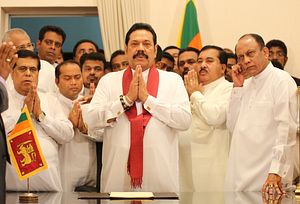For the last four days, Sri Lanka has found itself in the throes of a political storm that has been called everything from a constitutional crisis to a “soft coup.” At the center of the current crisis dynamics are three men: one president and two men who both claim to be the prime minister. The crisis was sparked when the incumbent president since January 2015, Maithripala Sirisena, announced that he would appoint his predecessor, Mahinda Rajapaksa, to the prime ministership to replace Ranil Wickremsinghe, the man who’d held the prime ministerial position since Sirisena’s election in 2015.
Sirisena had, after months of growing tensions with Wickremsinghe over domestic and foreign policy issues, decided that the moment was right to welcome Rajapaksa back to a position of influence. The decision immediately split the government that had formed in 2015 out of an alliance between Sirisena’s Sri Lanka Freedom Party (SLFP) and Wickremsinghe’s United National Party (UNP). Sirisena subsequently moved to dissolve his cabinet and suspend parliament. On Monday, he appointed a new cabinet.
Meanwhile, the constitutional question of Sirisena’s actions immediately came to the fore as Wickremsinghe refused to accept that he was no longer prime minister, arguing that he could prove that he commanded a majority of support from elected parliamentarians. To retain his claim to the position, Wickremsinghe has refused to vacate the prime minister’s official residence. Rajapaksa, meanwhile, is ascending to the office of prime minister just as several of his family members and former associates stand to face trial for corruption.
While Sirisena defeated Rajapaksa in the 2015 presidential election, he did not do so as an outsider. Until November 2014, he was the minister of health in Rajapaksa’s cabinet. His path to victory was paved with a strong sense of anti-incumbency toward Rajapaksa. That the two men would find space to reconcile three years on from that election is perhaps not so surprising — especially given their common ideological heritage.
The most serious challenge, as of this writing, is the possibility of widespread political violence in Sri Lanka as supporters of the SLFP, UNP, and Rajapaksa loyalists clash over the current crisis. Protesters have already moved to bar former members of Sirisena’s cabinet access to government facilities and, in at least one instance, this has resulted in bloodshed.
Sirisena has, in the meantime, ignored calls by the speaker of the Sri Lankan parliament, Karu Jayasuriya, to reconvene the parliament to address the constitutional crisis. “We should settle this through parliament, but if we take it out to the streets, there will be a huge bloodbath,” Jayasuriya told reporters on Monday. Sirisena has set the next parliamentary session for November 16, leaving a gap of more than two weeks where Sri Lankan lawmakers may be unable to address the crisis, increasing the odds of violence. Complicating the crisis, just one day before Rajapaksa was sworn in along with the new cabinet, Jayasuriya recognized Wickremsinghe as the lawful prime minister—ostensibly in a move to discourage Sirisena from proceeding with the formal duties-assuming ceremony for Rajapaksa.
For the moment, neither the United States or India have taken a position on the prime ministerial succession question directly, but Washington has indicated some degree of support for Wickremsinghe’s position on the constitutional question. The U.S. State Department released a statement over the weekend calling “on the President, in consultation with the Speaker, to immediately reconvene parliament and allow the democratically elected representatives of the Sri Lankan people to fulfill their responsibility to affirm who will lead their government.”
India has been more circumspect, biding its time to see how events develop while no doubt pursuing behind-the-scenes talks with the Sri Lankan government. “India is closely following the recent political developments in Sri Lanka. As a democracy and a close friendly neighbour, we hope that democratic values and the constitutional process will be respected,” the Indian Ministry of External Affairs noted in a statement.
For India, developments in Sri Lanka will draw great interest; Colombo has been an important node in Prime Minister Narendra Modi’s neighborhood policy. India has been aware of the shifting domestic political climes in Colombo. Sirisena, in the weeks leading up to his decision to replace Wickremsinghe, who’d been seen as generally more pro-India, Sirisena had alleged that he believed India’s external intelligence agency, the Research & Analysis Wing, was plotting to have him assassinated — a claim he later denied to Modi. Rajapaksa, meanwhile, has in New Delhi in September, hinting at a potential thaw between him and the Indian government.
In the meantime, however, China has taken the initiative and welcomed Rajapaksa’s announcement — no doubt eager to have the former strongman president back as prime minister. Rajapaksa, through his official Twitter account, noted that Cheng Xueyuan, China’s envoy in Colombo, conveyed “congratulatory wishes from Chinese President Xi Jinping” to him. Under Rajapaksa, Sri Lanka took on considerable debt to China, resulting in, among other things, the eventual debt-equity swap at Hambantota Port, which led to China acquiring the port on a 99-year lease on Sirisena’s watch. China’s willingness to unequivocally signal support for Rajapaksa suggests that Beijing sees little chance of Wickremsinghe staying on as prime minister.
The coming days will be critical for Sri Lanka. If Sirisena chooses to double-down and proceed without any parliamentary input on the current crisis and Wickremsinghe stands his ground, the crisis is sure to worsen.

































